A New Finite Element Formulation for Nonlinear Vibration Analysis of the Hard-Coating Cylindrical Shell
Abstract
:1. Introduction
2. Derivation of the Finite Element Formulation for the Hard-Coating Cylindrical Shell
2.1. Geometry and Element of the Hard-Coating Cylindrical Shell
2.2. Love’s First Approximation Theory
2.3. Finite Element Formulation
3. Characterizing the Strain Dependence Using the High Order Polynomial
4. Solution of the Nonlinear Vibration of the Hard-Coating Cylindrical Shell
5. Case Study
5.1. Validation Analysis
5.2. Nonlinear Vibration Analysis and Results Discussion
6. Conclusions
- Based on Love’s first approximation theory, a four-node composite cylindrical shell finite element model is proposed. Then, the nonlinear iterative solution formulas with a unified iterative method are theoretically derived for solving the resonant frequency and response of the hard-coating cylindrical shell.
- A cylindrical shell coated with a thin layer of NiCoCrAlY + YSZ is chosen to demonstrate the proposed formulation. The nonlinear resonant frequencies and responses calculated by the present method and the FEIM show a good agreement, which indicates the rationality of the developed finite element method. Moreover, the developed finite element method is less affected by the element size and has lower computing cost.
- Moreover, the nonlinear vibration analysis of the cylindrical shell coated with a thin layer of NiCoCrAlY + YSZ is implemented. Compared with the linear calculation results, the nonlinear resonant frequencies and responses of each order decrease to a certain degree, and the descents increase continually with the increase of the excitation level; that is, the increase of the excitation level would make the strain dependence of the hard-coating more remarkable, which reveals the characteristics of the soft stiffness nonlinearity or “strain softening”.
Acknowledgments
Author Contributions
Conflicts of Interest
References
- Jin, G.; Ye, T.; Chen, Y.; Su, Z.; Yan, Y. An exact solution for the free vibration analysis of laminated composite cylindrical shells with general elastic boundary conditions. Compos. Struct. 2013, 106, 114–127. [Google Scholar] [CrossRef]
- Limarga, A.M.; Duong, T.L.; Gregori, G.; Clarke, D.R. High-temperature vibration damping of thermal barrier coating materials. Surf. Coat. Technol. 2007, 202, 693–697. [Google Scholar] [CrossRef]
- Gregori, G.; Li, L.; Nychka, J.A.; Clarke, D.R. Vibration damping of superalloys and thermal barrier coatings at high-temperatures. Mater. Sci. Eng. A 2007, 466, 256–264. [Google Scholar] [CrossRef]
- Rodríguez-Barrero, S.; Fernández-Larrinoa, J.; Azkona, I.; López de Lacalle, L.N.; Polvorosa, R. Enhanced performance of nanostructured coatings for drilling by droplet elimination. Mater. Manuf. Process. 2016, 31, 593–602. [Google Scholar] [CrossRef]
- Fernández-Abia, A.I.; Barreiro, J.; López de Lacalle, L.N.; Martínez-Pellitero, S. Behavior of austenitic stainless steels at high speed turning using specific force coefficients. Int. J. Adv. Manuf. Technol. 2012, 62, 505–515. [Google Scholar] [CrossRef]
- Ivancic, F.T.; Palazotto, A.N. Experimental considerations for determining the damping coefficients of hard coatings. J. Aerosp. Eng. 2005, 18, 8–17. [Google Scholar] [CrossRef]
- Patsias, S.; Saxton, C.G.; Shipton, M.K. Hard damping coatings: an experimental procedure for extraction of damping characteristics and modulus of elasticity. Mater. Sci. Eng. A 2004, 370, 412–416. [Google Scholar] [CrossRef]
- Blackwell, C.W.; Palazotto, A.N.; George, T.; Cross, C. The evaluation of the damping characteristics of a hard coating on titanium. Shock Vib. 2007, 14, 37–51. [Google Scholar] [CrossRef]
- Tassini, N.; Patsias, S.; Lambrinou, K. Ceramic coatings: a phenomenological modeling for damping behavior related to microstructural features. Mater. Sci. Eng. A 2006, 442, 509–513. [Google Scholar] [CrossRef]
- Reed, S.A.; Palazotto, A.N.; Baker, W.P. An experimental technique for the evaluation of strain dependent material properties of hard coatings. Shock Vib. 2008, 15, 697–712. [Google Scholar] [CrossRef]
- Torvik, P.J. Determination of mechanical properties of non-linear coatings from measurements with coated beams. Int. J. Solids Struct. 2009, 46, 1066–1077. [Google Scholar] [CrossRef]
- Sun, W.; Liu, Y. Vibration analysis of hard-coated composite beam considering the strain dependent characteristic of coating material. Acta Mech. Sin. 2016, 32, 1–12. [Google Scholar] [CrossRef]
- Chen, Y.G.; Zhai, J.Y.; Han, Q.K. Vibration and damping analysis of the bladed disk with damping hard coating on blades. Aerosp. Sci. Technol. 2016, 58, 248–257. [Google Scholar] [CrossRef]
- Sun, W.; Zhu, M.W.; Wang, Z. Free vibration analysis of a hard-coating cantilever cylindrical shell with elastic constraints. Aerosp. Sci. Technol. 2017, 63, 232–244. [Google Scholar] [CrossRef]
- Filippi, S.; Torvik, P.J. A methodology for predicting the response of blades with nonlinear coatings. J. Eng. Gas Turbines Power 2011, 133, 984–992. [Google Scholar] [CrossRef]
- Li, H.; Liu, Y.; Sun, W. Analysis of nonlinear vibration of hard coating thin plate by finite element iteration method. Shock Vib. 2014, 21, 1–12. [Google Scholar] [CrossRef]
- Wang, T.; Tang, W.; Zhang, S. Nonlinear dynamic response and buckling of laminated cylindrical shells with axial shallow groove based on a semi-analytical method. J. Shanghai Univ. Engl. Ed. 2007, 11, 223–228. [Google Scholar] [CrossRef]
- Naidu, N.V.; Sinha, P.K. Nonlinear finite element analysis of laminated composite shells in hygrothermal environments. Compos. Struct. 2005, 69, 387–395. [Google Scholar]
- Patel, B.; Nath, Y.; Shukla, K.K. Nonlinear thermo-elastic buckling characteristics of cross-ply laminated joined conical-cylindrical shells. Int. J. Solids Struct. 2006, 43, 4810–4829. [Google Scholar] [CrossRef]
- Khoroshun, L.P.; Babich, D.V.; Shikula, E.N. Stability of cylindrical shells made of a particulate composite with nonlinear elastic inclusions and damageable matrix. Int. Appl. Mech. 2007, 43, 1123–1131. [Google Scholar] [CrossRef]
- Ferreira, A.J.; Sa, J.M.; Marques, A.T. Nonlinear finite element analysis of rubber composite shells. Strength Mater. 2003, 35, 225–235. [Google Scholar] [CrossRef]
- Masti, R.S.; Sainsbury, M. Vibration damping of cylindrical shells partially coated with a constrained viscoelastic treatment having a standoff layer. Thin Walled Struct. 2005, 43, 1355–1379. [Google Scholar] [CrossRef]
- Love, A. A treatise on the mathematical theory of elasticity. Nature 1944, 47, 529–530. [Google Scholar]
- Cho, M.; Kim, J. A postprocess method for laminated shells with a doubly curved nine-noded finite element. Compos. Part B Eng. 2000, 31, 65–74. [Google Scholar] [CrossRef]
- Lam, K.Y.; Loy, C.T. Effects of boundary conditions on frequencies of a multi-layered cylindrical shell. J. Sound Vib. 1995, 188, 363–384. [Google Scholar] [CrossRef]
- Sun, W.; Wang, Z.; Zhu, M.; Du, G. Identifying the mechanical parameters of hard coating with strain dependent characteristic by an inverse method. Shock Vib. 2015, 2, 1–15. [Google Scholar] [CrossRef]
- Groll, G.V.; Ewins, D.J. The harmonic balance method with arc-length continuation in rotor/stator contact problems. J. Sound Vib. 2001, 241, 223–233. [Google Scholar] [CrossRef]
- Petrov, E.P.; Ewins, D.J. Method for analysis of nonlinear multiharmonic vibrations of mistuned bladed disks with scatter of contact interface characteristics. J. Turbomach. 2005, 127, 128–136. [Google Scholar] [CrossRef]
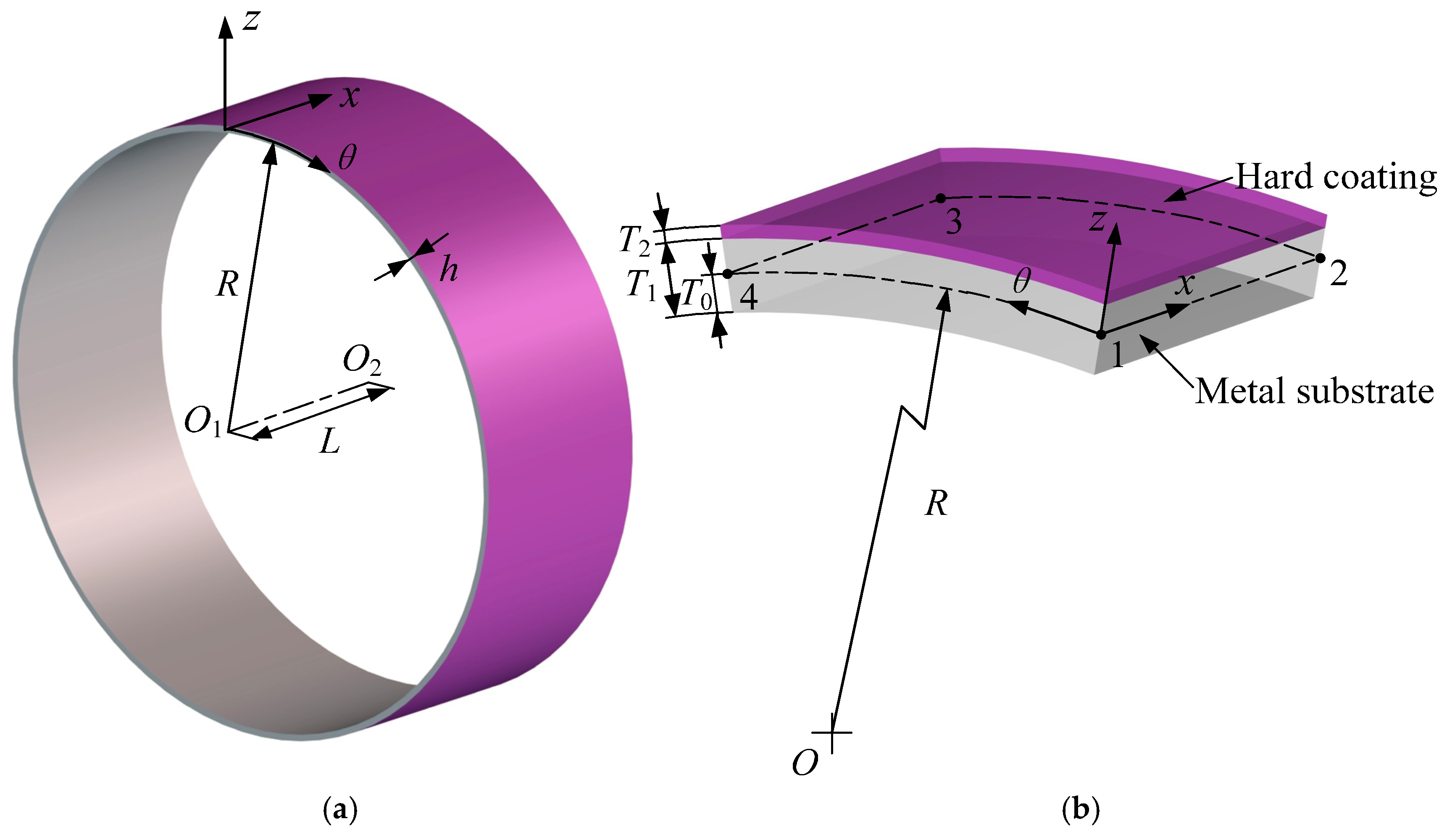
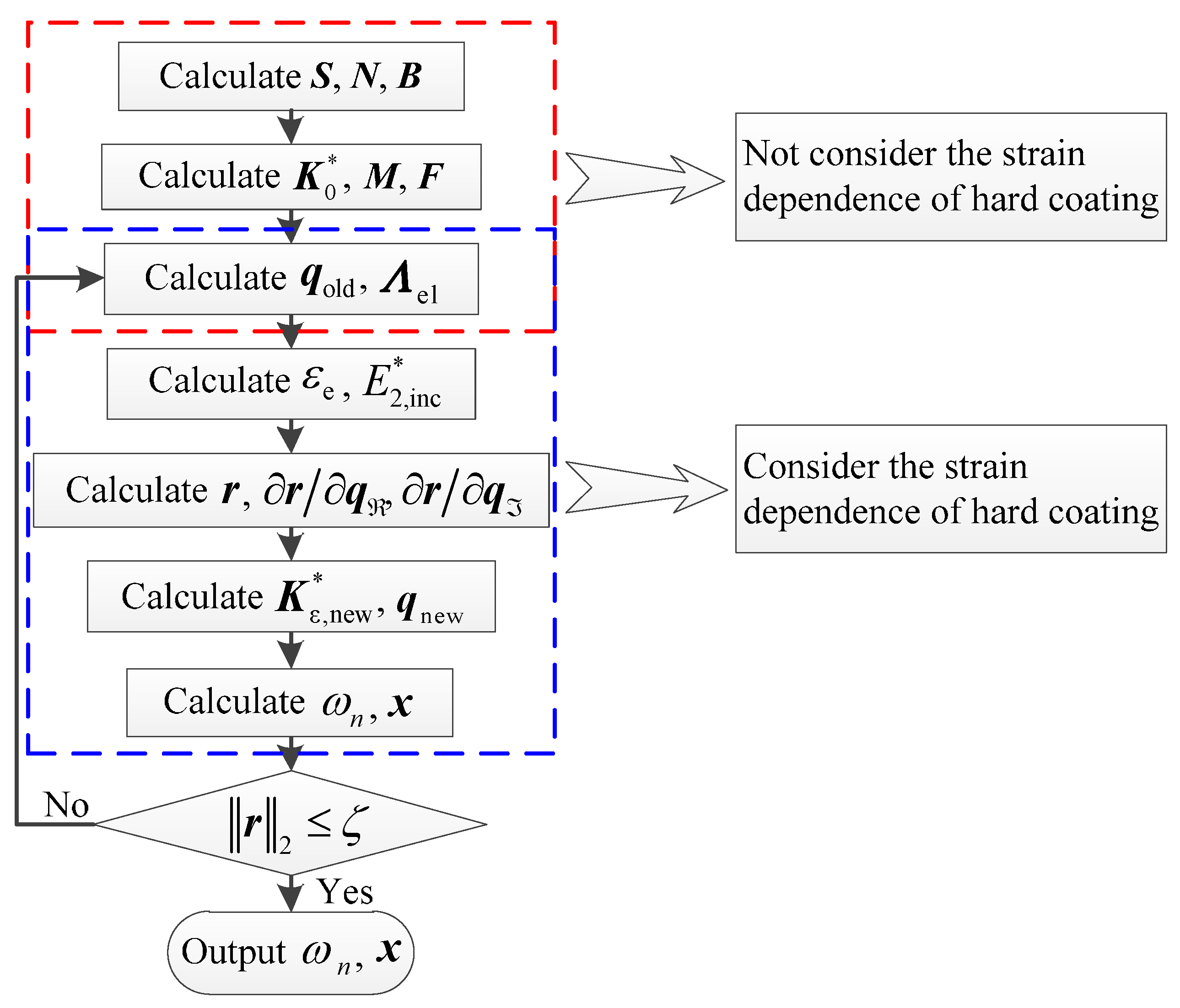
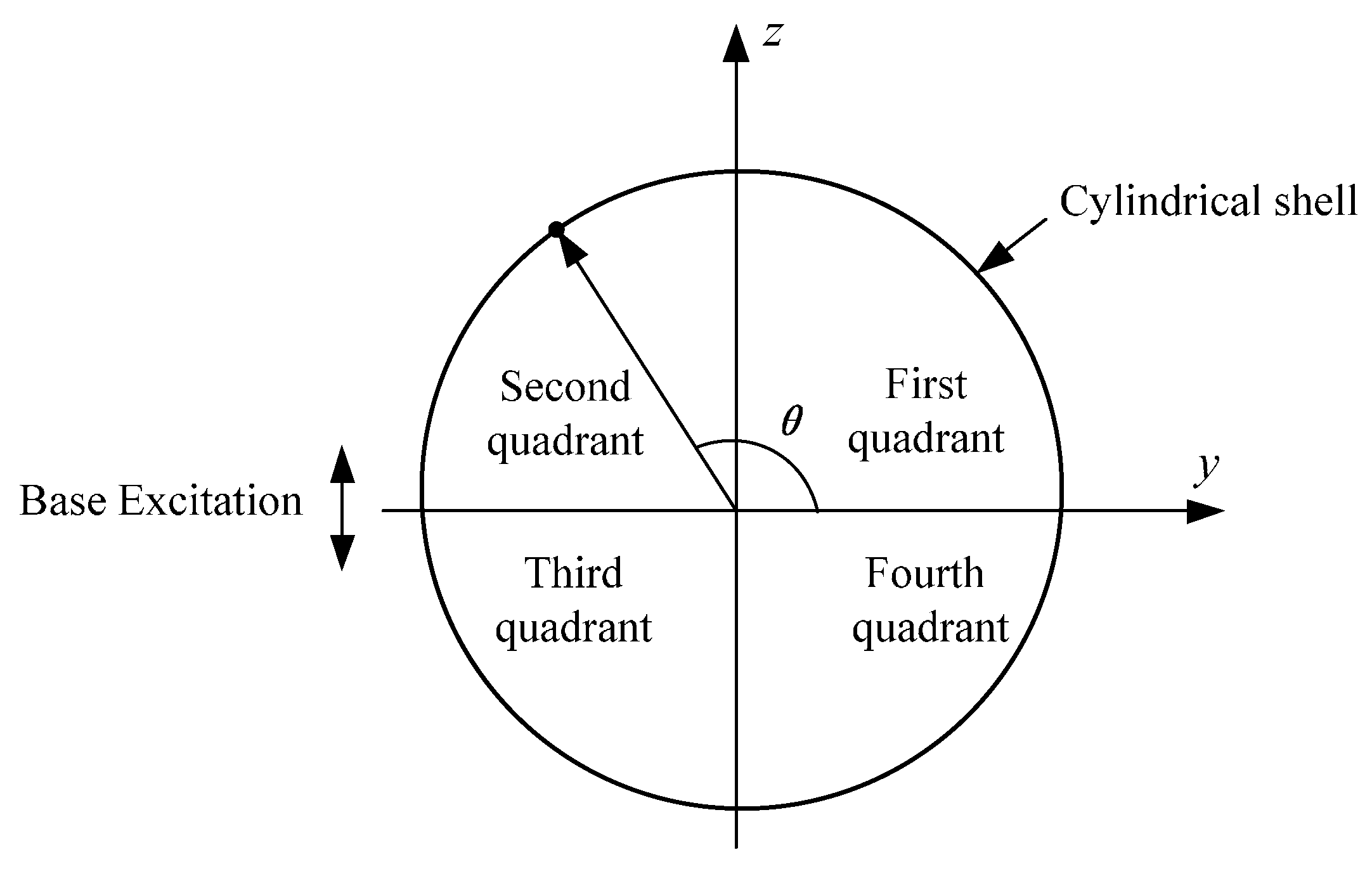
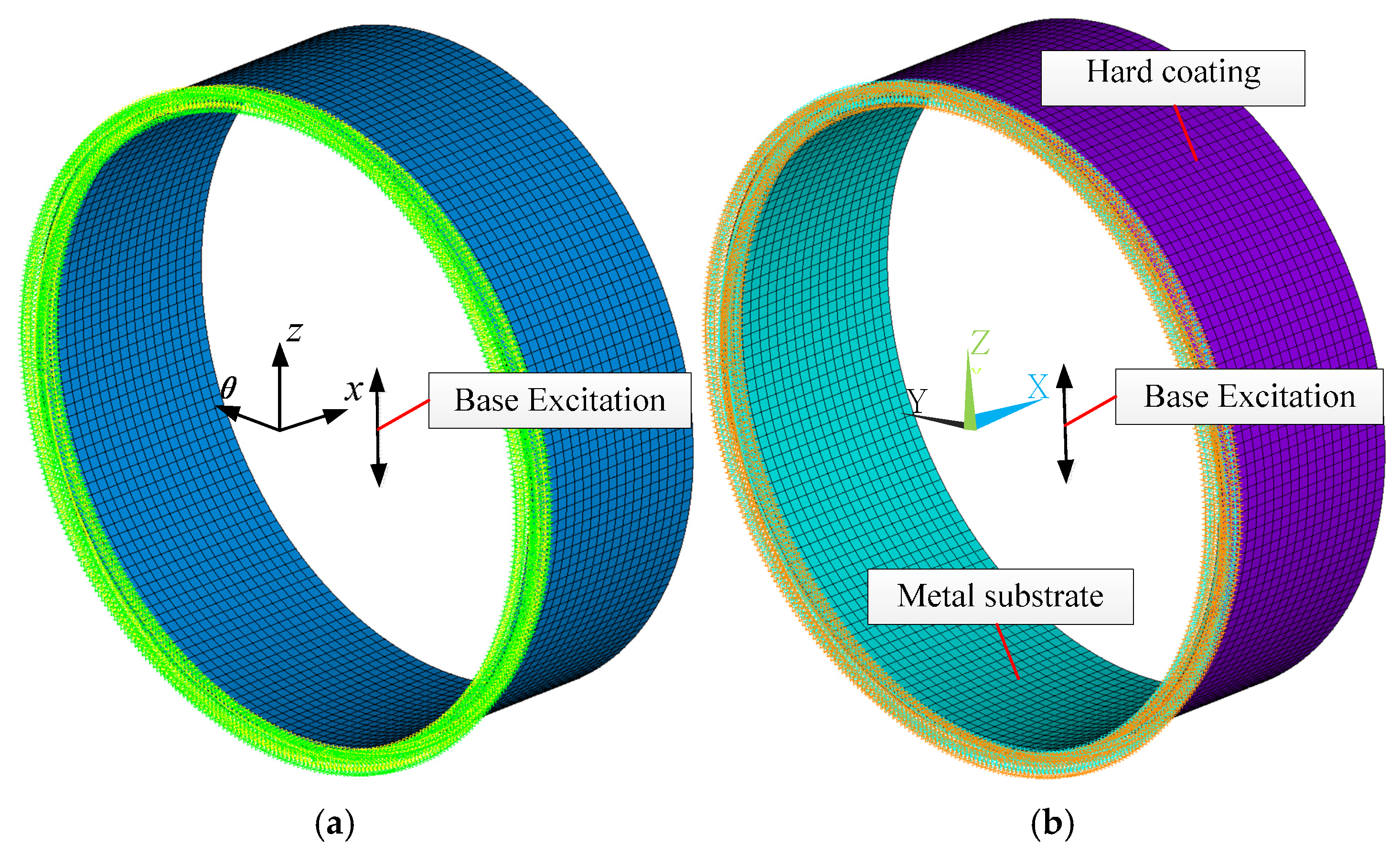
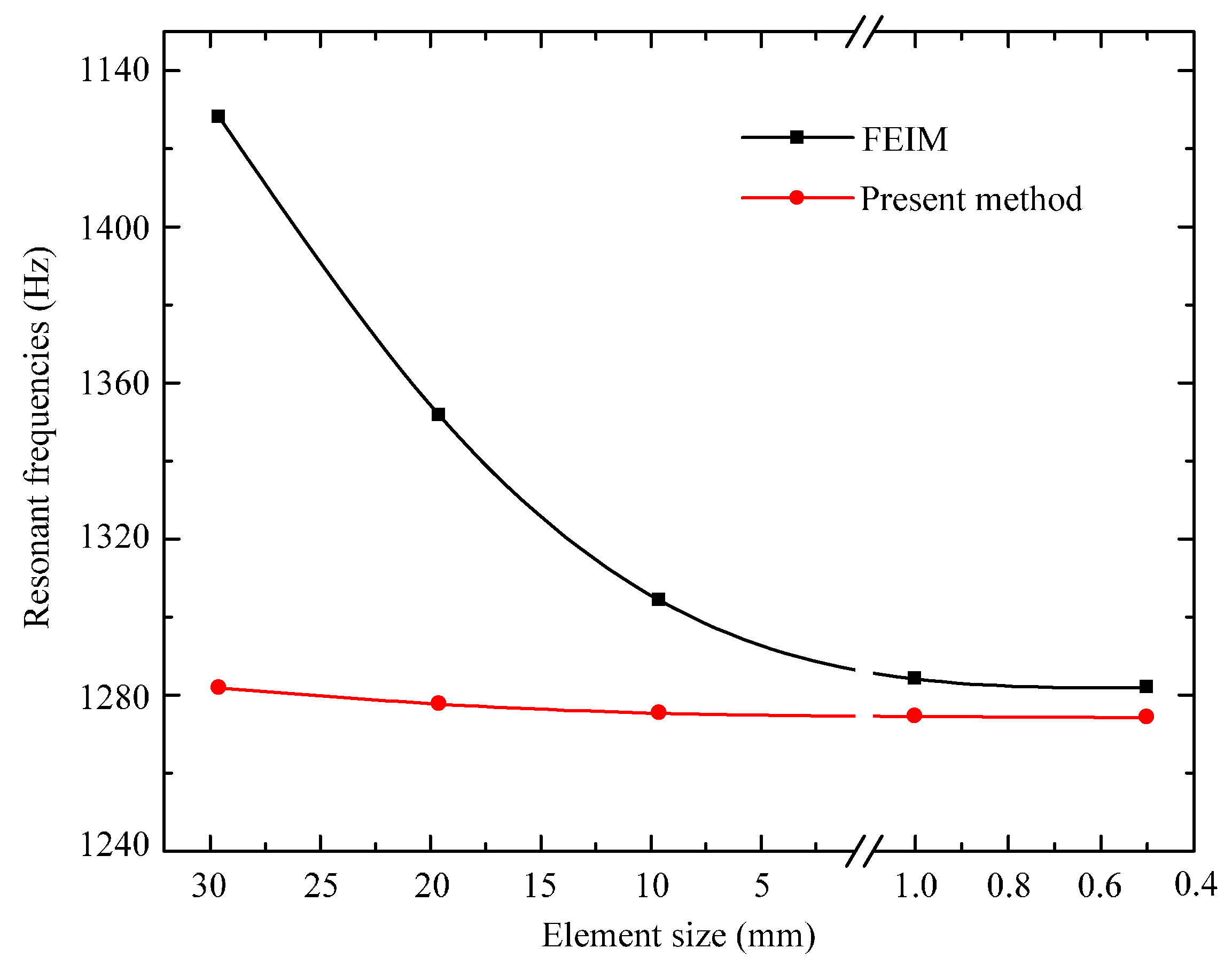

| Parameters | L (mm) | R (mm) | T1 (mm) | T2 (mm) |
|---|---|---|---|---|
| Value | 95 | 142 | 2 | 0.31 |
| Lamina | Material | Young’s Modulus (GPa) | Loss Factor | Density (kg/m3) | Poisson’s Ratio |
|---|---|---|---|---|---|
| Metal substrate | Ti-6Al-4V | 110.32 | 0.0007 | 4420 | 0.3 |
| Hard coating | NiCoCrAlY + YSZ | E2 | η2 | 5600 | 0.3 |
| Quadrant | μθ | μz |
|---|---|---|
| First | cosθ | sinθ |
| Second | sinθ | −cosθ |
| Third | −cosθ | −sinθ |
| Fourth | cosθ | −sinθ |
| Modal Order | Nonlinear Resonant Frequencies | Nonlinear Resonant Responses | ||||
|---|---|---|---|---|---|---|
| Present Method A (Hz) | FEIM B (Hz) | Difference |A − B|/A (%) | Present Method C (10−2 mm) | FEIM D (10−2 mm) | Difference |C − D|/C (%) | |
| 1 | 1274.561 | 1281.912 | 0.577 | 1.786 | 1.738 | 2.732 |
| 2 | 1283.778 | 1294.985 | 0.873 | 3.199 | 3.048 | 4.940 |
| 3 | 1443.842 | 1446.837 | 0.207 | 1.753 | 1.705 | 2.793 |
| 4 | 1513.250 | 1526.021 | 0.844 | 1.409 | 1.345 | 4.753 |
| 5 | 1738.061 | 1736.589 | 0.085 | 1.172 | 1.164 | 0.702 |
| 6 | 1990.964 | 2002.791 | 0.594 | 1.239 | 1.200 | 3.259 |
| Modal Order | Linear (Hz) E | Nonlinear (Hz) F | Descent (Hz) E − F |
|---|---|---|---|
| 1 | 1274.899 | 1274.561 | 0.338 |
| 2 | 1283.922 | 1283.778 | 0.144 |
| 3 | 1444.074 | 1443.842 | 0.232 |
| 4 | 1513.410 | 1513.25 | 0.160 |
| 5 | 1738.293 | 1738.061 | 0.232 |
| 6 | 1991.071 | 1990.964 | 0.107 |
| Modal Order | Linear (10−2 mm) G | Nonlinear (10−2 mm) H | Descent (10−2 mm) G − H |
|---|---|---|---|
| 1 | 8.926 | 8.529 | 0.397 |
| 2 | 16.003 | 15.472 | 0.531 |
| 3 | 8.740 | 8.444 | 0.296 |
| 4 | 7.067 | 6.794 | 0.273 |
| 5 | 5.869 | 5.714 | 0.155 |
| 6 | 6.195 | 6.067 | 0.128 |
| Excitation Level (g) | Linear (Hz) E | Nonlinear (Hz) F | Descent (Hz) E − F |
|---|---|---|---|
| 1 | 1444.074 | 1444.026 | 0.048 |
| 3 | 1444.074 | 1443.932 | 0.142 |
| 5 | 1444.074 | 1443.842 | 0.232 |
| 7 | 1444.074 | 1443.755 | 0.319 |
| 9 | 1444.074 | 1443.672 | 0.402 |
| Excitation Level (g) | Linear (10−2 mm) G | Nonlinear (10−2 mm) H | Descent (10−2 mm) G − H |
|---|---|---|---|
| 1 | 1.752 | 1.741 | 0.011 |
| 3 | 5.246 | 5.136 | 0.110 |
| 5 | 8.740 | 8.444 | 0.296 |
| 7 | 12.234 | 11.641 | 0.593 |
| 9 | 15.738 | 14.728 | 1.010 |
© 2017 by the authors. Licensee MDPI, Basel, Switzerland. This article is an open access article distributed under the terms and conditions of the Creative Commons Attribution (CC BY) license (http://creativecommons.org/licenses/by/4.0/).
Share and Cite
Zhang, Y.; Sun, W.; Yang, J. A New Finite Element Formulation for Nonlinear Vibration Analysis of the Hard-Coating Cylindrical Shell. Coatings 2017, 7, 70. https://doi.org/10.3390/coatings7050070
Zhang Y, Sun W, Yang J. A New Finite Element Formulation for Nonlinear Vibration Analysis of the Hard-Coating Cylindrical Shell. Coatings. 2017; 7(5):70. https://doi.org/10.3390/coatings7050070
Chicago/Turabian StyleZhang, Yue, Wei Sun, and Jian Yang. 2017. "A New Finite Element Formulation for Nonlinear Vibration Analysis of the Hard-Coating Cylindrical Shell" Coatings 7, no. 5: 70. https://doi.org/10.3390/coatings7050070
APA StyleZhang, Y., Sun, W., & Yang, J. (2017). A New Finite Element Formulation for Nonlinear Vibration Analysis of the Hard-Coating Cylindrical Shell. Coatings, 7(5), 70. https://doi.org/10.3390/coatings7050070






